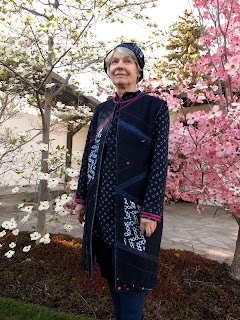 |
| Nomadsally's Fiber Studio |
Here we sit in my studio filled with fabric everywhere, on the floor, in the chairs and baskets.... There is fiber from Asia, Africa, Middle East, Jo-Ann's, Hancock's, Bernina, and even some that I wove myself. And, I love to roll around in it. But the question today is what am I going to make? How do I make decisions and selections from the multitude of options possible. Sometimes it is confusing but most often I love the choices.
 |
| Possibilities |
 |
| Japanese Shibori - Tie Dye Seminole Patchwork |
I am beginning to focus on which fabrics, techniques, and embellishments to embrace. As you note the blues seem to dominate as well as the Japanese crafted shibori flowers ( above left). Shibori is a Japanaese word that refers to a tie-dye process and the intricately tied piece above illustrates an extremely delicate technique.
Another choice that seems to float above the rest is my seminole patchwork, illustrated in the left view. Seminole is unique quilt technique that has come from the Seminole Tribe of North America. The delight of this technique is the unpredictable nature of the results. There are many elements to consider when creating seminole: thickness of fabrics, the choice of the joined fabrics and trying to predict what the resulting pattern will be, and last but not least, how to incorporate these exotic pieces into a garment. I was playing with Seminole work last year and loved the results of some of the patterns that resulted. So, why not incorporate it in my study of blues?
Out with the drafting book to make drawings, pattern options, and a plan of attack.
The initial construction will be to encase the zigzag seminole quilting pattern in the Guatemalan indigo fabric which will become part of the jacket front pieces.
 |
| Seminole Work Encased in Blues |

The work on the fronts began. I decided that the very simple lines of Lois Ericson's pattern The Wedge #324 would allow the most creativity. Blue and raspberry tone silk bias strips were added to embellish neckline, armholes, fronts, back, and lining. Small buttons of the above mentioned colors add dimension and more vibrancy to strips of silk and cording. The metallic blue hand sewing bordering all pieces adds the finishing touch. Great threads can make all the difference in the finishing step. Our local Bernina store has carried some wonderful textured threads that add pizazz and dimension to textile work.
 |
| Front and Side Views |
 |
| Front View |
 |
| Vibrant Back |
Above you see the latest creation.....hand dyed indigo blue cotton from the Chichicastenango, Guatemalan market purchased in the 80's. The highlight and inspiration for making my sleeveless coat is the strong white floral design ( viewed on the back piece ). This fabric manipulation technique is called shibori and is most intensive in execution. Many areas of the world, ancient and modern have employed shibori in their fiber work, but the Japanese excel in quality. The technique requres delicate tying and dying of fabric -- like the tie dye of the 60's, except the Japanese carry the art to an incredibly complex level. In my opinon, shibori, especially Japanese shibori is the goddess of all fabric manipulation. The classic text for the technique is
Shibori. The Inventive Art of Japanese Shaped Resist
 Dyeing
Dyeing by Yoshiko Iwamoto, Mary Kellogg Rice and Jane Barton.
|
|
Seminole Patchwork Technique
|
Another technique featured in the front of the coat is the Seminole technique which originates from our American Seminole Indians.
Currently, I am engaged in additional embellishment of the coat -- adding bias strips, buttons, embroidering and whatever it seems to need. Step by step it is developing a sense of unity and completeness. I always enjoy this part of a creation -- it's like putting the frosting on a cake!
 |
| Shibori Work/Tie Dye |
Shibori Tunic or Kurta. Of course it is indigo shibori fabric from China. I wanted a simple top with vibrant sleeves to complement the Sheminole Long Vest and my Jodhpur pants. Vogue answered my call with Pattern 7315 and its elegant neckline and comfortable sleeves.
 |
Tunic or Kurta
What is missing? A hat...... Looking at my collection of hat styles,I decided that the cloche would be perfect. Gathering form details from one of my cloche hats and from Burda online, I cut eight wedges (lined) to form the upper hat and then prepared a band to complete the cloche look. The construction was fun and results indicate that I did have some good fortune. The fit is so comfortable that I am unaware of even wearing a headpiece. And, the small pieces of fabric required are a great way to utilize all those small wonderful remnants that you just can't toss! |
 |
| Front View of Cloche |
Crowning Glory of Cloche
By now you can imagine why I call the outfit, Sheminole. It is a combination of Seminole and Shibori work. Sounds strange but it works!
 |
| Admiring the Dogwoods |
 |
| Sheminole Rejoices |
Thanks for traveling with me along the fabric roads of our world.
I enjoyed each step of the Sheminole experience.









 Dyeing by Yoshiko Iwamoto, Mary Kellogg Rice and Jane Barton.
Dyeing by Yoshiko Iwamoto, Mary Kellogg Rice and Jane Barton.








No comments:
Post a Comment